International Journal of Computer Network and Information Security @ijcnis
Статьи журнала - International Journal of Computer Network and Information Security
Все статьи: 1177
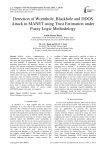
Статья научная
Mobile ad-hoc communication is a spontaneous network because the topology is not stationary but self-organized. This requires that during the time MANET it operational, all the processes regarding discovering the topology, delivery of data packets and internal management communications must be taken care by the node(s) themselves. This implies the criteria for selection of Cluster Head (CH) and the routing related protocols are to be integrated into mobile node(s).The very facts that MANET is challenging and innovative areas of wireless networks, makes it more vulnerable in term of routing and flooding attacks. In this paper, a node trust calculation methodology is proposed which calculate the trust value of each node and applies fuzzy logic to detect wormhole, Black-hole (Routing attack) and distributed denial of service attack (DDOS/Flooding) in dynamic environment.
Бесплатно
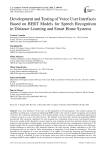
Статья научная
Voice User Interfaces (VUIs) focus on their application in IT and linguistics. Our research examines the capabilities and limitations of small and multilingual BERT models in the context of speech recognition and command conversion. We evaluate the performance of these models through a series of experiments, including the application of confusion matrices to assess their effectiveness. The findings reveal that larger models like multilingual BERT theoretically offer advanced capabilities but often demand more substantial resources and well-balanced datasets. Conversely, smaller models, though less resource-intensive, may sometimes provide more practical solutions. Our study underscores the importance of dataset quality, model fine-tuning, and efficient resource management in optimising VUIS. Insights gained from this research highlight the potential of neural networks to enhance and improve user interaction. Despite challenges in achieving a fully functional interface, the study provides valuable contributions to the VUIs development and sets the stage for future advancements in integrating AI with linguistic technologies. The article describes the development of a voice user interface (VUI) capable of recognising, analysing, and interpreting the Ukrainian language. For this purpose, several neural network architectures were used, including the Squeezeformer-CTC model, as well as a modified w2v-bert-2.0-uk model, which was used to decode speech commands into text. The multilingual BERT model (mBERT) for the classification of intentions was also tested. The developed system showed the prospects of using BERT models in combination with lightweight ASR architectures to create an effective voice interface in Ukrainian. Accuracy indicators (F1 = 91.5%, WER = 12.7%) indicate high-quality recognition, which is provided even in models with low memory capacity. The system is adaptable to conditions with limited resources, particularly for educational and living environments with a Ukrainian-speaking audience.
Бесплатно
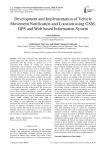
Статья научная
The issue of Crimes been committed in our society these days has become an issue that every government and the society in general has to be concerned with. Stolen of vehicle has increased tremendously and sometimes such vehicle are used in committing criminal activities such as armed robbery, kidnapping and of recent insurgency as it is been witness in some part of Nigeria. In view of these challenges, adequate provision or records of stolen, identified and recovered vehicle are not readily available and as such very important. The development of vehicle movement notification and location is one of the solutions to vehicles owner in order to ensure speedy notification, identification and recovery of their vehicles and as well reduce criminal activities in the society. The system uses a developed application installed in a mobile phone device which will be embedded in a vehicle to notify the owner when the vehicle is driven by unauthorized user. A GSM mobile phone was used to communicate with the vehicle owner whereby the user sends SMS to communicate with the mobile phone sensor installed in the vehicle. A web application was also developed to determine the real-time vehicle location and as well as record of database information system of found or missing vehicles. The system was test run and the results obtained shows how effectiveness is it in determining vehicle movement, location and notification as it is been driven within or outside its jurisdiction.
Бесплатно
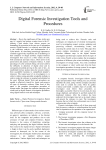
Digital Forensic Investigation Tools and Procedures
Статья научная
Due to the significance of Data, in this new age, its’ security has become a major issue in the I.T. industry. Cyber attacks from various sources are demanding its prevention in the new era of information security. Digital forensic is a relatively new fields that is the collection, analysis and documentation of a Cyber attacks. It is becoming increasingly important as criminals aggressively expand the use of technology in their enterprise of illegal activities. Digital forensics investigators have access to a wide variety of tools, both commercial and open source, which assist in the preservation and analysis of digital evidence. A small percentage of cyber criminals being convicted confirm the difficulty in detection of digital crime and its consequent procedural proving in the court of law. An established forensic analyst mines the crucial evidence from susceptible locations to comprehend attacker’s intension. The typical goal of an investigation is to collect evidence using generally acceptable methods in order to make the evidence is accepted and admitted on the court. Efficient digital Tools and procedures are needed to effectively search for, locate, and preserve all types of electronic evidence. Main focus of this paper is the complete investigation procedure of storage media. Our paper also explains emerging cyber crimes and its digital forensic investigation procedures using digital forensic tools and techniques.
Бесплатно
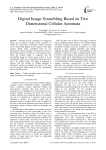
Digital Image Scrambling Based on Two Dimensional Cellular Automata
Статья научная
The basic idea of scrambling is to change the image pixel positions through matrix transform to achieve the visual effect of disorder. Cellular automata can be successfully applied for this purpose. This paper presents digital image scrambling based on two dimensional cellular automata. The proposed scheme is shown high quality of confusion in a few evolution steps. When the original image is compared with the descrambled image by human visual system, it is not recognizable which one is descrambled image and which one is the original image. The paper is organised as follows: first the concept of cellular automata is introduced, and then accordingly the game of life rules and the proposed model followed by the experimental results with discussions.
Бесплатно
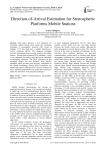
Direction-of-Arrival Estimation for Stratospheric Platforms Mobile Stations
Статья научная
This paper presents a new approach for localizing mobile phone users using the promising technique of stratospheric platform (SP) flying at altitudes 17-22 km high and a suitable Direction-of-Arrival technique (DOA). The proposed technique provides information about accurate locations for mobile stations - through high resolution DOA technique - which is very important for traffic control and rescue operations at emergency situations. The DOA estimation in this technique defines the user location using MUSIC algorithm which provides good accuracy comparable to the Global Positioning System (GPS) techniques but without the need for GPS receivers. Several scenarios for users’ locations determination are tested and examined to define the robustness of the proposed technique.
Бесплатно
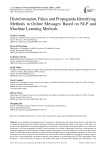
Статья научная
A new method of propaganda analysis is proposed to identify signs and change the dynamics of the behaviour of coordinated groups based on machine learning at the processing disinformation stages. In the course of the work, two models were implemented to recognise propaganda in textual data - at the message level and the phrase level. Within the framework of solving the problem of analysis and recognition of text data, in particular, fake news on the Internet, an important component of NLP technology (natural language processing) is the classification of words in text data. In this context, classification is the assignment or assignment of textual data to one or more predefined categories or classes. For this purpose, the task of binary text classification was solved. Both models are built based on logistic regression, and in the process of data preparation and feature extraction, such methods as vectorisation using TF-IDF vectorisation (Term Frequency – Inverse Document Frequency), the BOW model (Bag-of-Words), POS marking (Part-Of-Speech), word embedding using the Word2Vec two-layer neural network, as well as manual feature extraction methods aimed at identifying specific methods of political propaganda in texts are used. The analogues of the project under development are analysed the subject area (the propaganda used in the media and the basis of its production methods) is studied. The software implementation is carried out in Python, using the seaborn, matplotlib, genism, spacy, NLTK (Natural Language Toolkit), NumPy, pandas, scikit-learn libraries. The model's score for propaganda recognition at the phrase level was obtained: 0.74, and at the message level: 0.99. The implementation of the results will significantly reduce the time required to make the most appropriate decision on the implementation of counter-disinformation measures concerning the identified coordinated groups of disinformation generation, fake news and propaganda. Different classification algorithms for detecting fake news and non-fakes or fakes identification accuracy from Internet resources ana social mass media are used as the decision tree (for non-fakes identification accuracy 0.98 and fakes identification accuracy 0.9903), the k-nearest neighbours (0.83/0.999), the random forest (0.991/0.933), the multilayer perceptron (0.9979/0.9945), the logistic regression (0.9965/0.9988), and the Bayes classifier (0.998/0.913). The logistic regression (0.9965) the multilayer perceptron (0.9979) and the Bayesian classifier (0.998) are more optimal for non-fakes news identification. The logistic regression (0.9988), the multilayer perceptron (0.9945), and k-nearest neighbours (0.999) are more optimal for identifying fake news identification.
Бесплатно
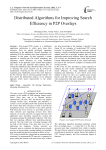
Distributed Algorithms for Improving Search Efficiency in P2P Overlays
Статья научная
Peer-to-peer (P2P) overlay is a distributed application architecture in which peers share their resources. Peers are equally privileged, equipotent participants in the application. Several algorithms for enhancing P2P file searching have been proposed in the literature. In this paper, we have proposed a unique approach of reducing the P2P search complexity and improving search efficiency by using distributed algorithms. In our approach a peer mounts other popular peer's files and also replicates other popular files or critical files identified using a threshold value. Once a file is mounted, file access requests can be serviced by transparently retrieving the file and sending it to the requesting peer. Replication used in this work improves the file retrieval time by allowing parallel transfer. We have shown the performance analysis of our proposed approach which shows improvement in the search efficiency.
Бесплатно
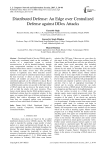
Distributed Defense: An Edge over Centralized Defense against DDos Attacks
Статья научная
Distributed Denial of Service (DDoS) attack is a large-scale, coordinated attack on the availability of services of a target/victim system or network resource/service. It can be launched indirectly through many compromised machines on the Internet. The Purpose behind these attacks is exhausting the existing bandwidth and makes servers deny from providing services to legitimate users. Most detection systems depend on some type of centralized processing to analyze the data necessary to detect an attack. In centralized defense, all modules are placed on single point. A centralized approach can be vulnerable to attack. But in distributed defense, all of the defense modules are placed at different points and do not succumb to the high volume of DDoS attack and can discover the attacks timely as well as fight the attacks with more resources. These factors clearly indicate that the DDoS problem requires a distributed solution than the centralized solution. In this paper, we compare both types of defense mechanisms and identify their relative advantages and disadvantages. Later they are compared against some performance metrics to know which kind of solution is best.
Бесплатно
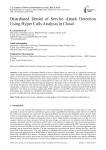
Distributed Denial of Service Attack Detection Using Hyper Calls Analysis in Cloud
Статья научная
In the scenario of Distributed Denial of Service (DDoS) attacks are increasing in a significant manner, the attacks should be mitigated in the beginning itself to avoid its devastating consequences for any kind of business. DDoS attack can slow down or completely block online services of business like websites, email or anything that faces internet. The attacks are frequently originating from cloud virtual machines for anonymity and wide network bandwidth. Hyper-Calls Analysis(HCA) enables the tracing of command flow to detect any clues for the occurrence of malicious activity in the system. A DDoS attack detection approach proposed in this paper works in the hypervisor side to perform hyper calls based introspection with machine learning algorithms. The system evaluates system calls in hypervisor for the classification of malicious activities through Support Vector Machine and Stochastic Gradient Descent (SVM & SGD) Algorithms. The attack environment created using XOIC attacker tool and CPU death ping libraries. The system’s performance also evaluated on CICDDOS 2019 dataset. The experimental results reveal that more than 99.6% of accuracy in DDoS detection without degrading performance.
Бесплатно
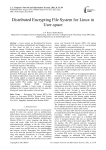
Distributed Encrypting File System for Linux in User-space
Статья научная
Linux systems use Encrypting File System (EFS) for providing confidentiality and integrity services to files stored on disk in a secure, efficient and transparent manner. Distributed encrypting file system should also provide support for secure remote access, multiuser file sharing, possible use by non-privileged users, portability, incremental backups etc. Existing kernel-space EFS designed at file system level provides all necessary features, but they are not portable and cannot be mounted by non-privileged users. Existing user-space EFS have performance limitations and does not provide support for file sharing. Through this paper, modifications in the design and implementation of two existing user-space EFS, for performance gain and file sharing support, has been presented. Performance gain has been achieved in both the proposed approaches using fast and modern ciphers. File sharing support in proposed approaches has been provided with Public Key Infrastructure (PKI) integration using GnuPG PKI module and Linux Pluggable Authentication Module (PAM) framework. Cryptographic metadata is being stored as extended attributes in file's Access Control List (ACL) to make file sharing task easier and seamless to the end user.
Бесплатно
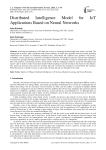
Distributed Intelligence Model for IoT Applications Based on Neural Networks
Статья научная
Increasing the implication of IoT data puts a focus on extracting the knowledge from sensors’ raw data. The management of sensors’ data is inefficient with current solutions, as studies have generally focused on either providing cloud-based IoT solutions or inefficient predefined rules. Cloud-based IoT solutions have problems with latency, availability, security and privacy, and power consumption. Therefore, Providing IoT gateways with relevant intelligence is essential for gaining knowledge from raw data to make the decision of whether to actuate or offload tasks to the cloud. This work proposes a model that provides an IoT gateway with the intelligence needed to extract the knowledge from sensors’ data in order to make the decision locally without needing to send all raw data to the cloud over the Internet. This speeds up decisions and actions for real-time data and overcomes the limitations of cloud-based IoT solutions. When the gateway is unable to process a task locally, the data and task are offloaded to the cloud.
Бесплатно
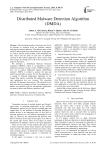
Distributed Malware Detection Algorithm (DMDA)
Статья научная
The increasing number of malwares has led to an increase in research work on malware analysis studying the malware behavior. The malware tries to leak sensitive information from infected devices. In this paper, we study a specific attack method, which distributes the data source and the point of data loss on different versions of the malware application. That is done using local storage by storing part or all of the vital data to be leaked in the future. We introduce a Distributed Malware Detection Algorithm (DMDA), which is an algorithm to detect distributed malware on app versions. DMDA proposes a new way to analyze application against redistributed malware. DMDA is created to analyze the data and identify transitional loss points. We test this algorithm on a sample of Android applications published on the Google Play market containing 100 applications, where each application has two versions. The algorithm detected 150 transient data sources, 200 transient loss of data point and two leakages of data. In comparison, this dataset was checked using 56 anti-malware applications but none of them could find any malicious code.
Бесплатно
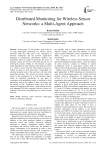
Distributed Monitoring for Wireless Sensor Networks: a Multi-Agent Approach
Статья научная
In this paper, we will present a state of the art in using multi-agent technology for wireless sensor networks where the main goal is the conception of software architecture and the network organization dedicated to optimization, performance analysis, and monitoring. Then we explore in particular, the issues of topology control and works in this field and the use of multi-agent systems. Finally we will propose an agent based algorithm for fault tolerance and topology control in a wireless sensor network. Our proposal consists to embed an agent at each node that is responsible for selecting its parent node or the next hop to the sink when transferring packets. The process of parent change is based on the computation of a fault tolerance degree which is calculated periodically by the agent in cooperation with neighboring nodes, in addition to other parameters such as the number of hops, the energy and the quality of link. Simulation results show that this method of changing parent allows a fault tolerant network with enhanced life time compared with the collect tree protocol CTP used for data gathering in a wireless sensor network.
Бесплатно
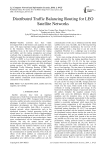
Distributed Traffic Balancing Routing for LEO Satellite Networks
Статья научная
Satellite networks have been widely investigated both in the business and academia for many years, with many important routing algorithms reported in the literatures. However, fewer existing routing algorithms focus on the trade-off between the routing survivability and the routing computation and storage overheads. Due to topological dynamics, it is difficult to effectively apply the conventional routing protocols such as RIP or OSPF to Low Earth Orbit (LEO) satellite networks. According to the virtual topology model based on virtual node, this paper propose a new fully distributed routing protocol for LEO satellite networks, called Distributed Traffic Balancing Routing (DTBR). The proposed protocol not only guarantees the routing survivability and provides the ability of traffic balancing, but also result in few additional computation and storage overheads only deriving from the information flooding of failed satellites. Simulation results demonstrate positive conclusions of our methods.
Бесплатно
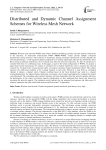
Distributed and Dynamic Channel Assignment Schemes for Wireless Mesh Network
Статья научная
Wireless mesh network (WMN) with wireless backhaul technology provides last-mile Internet connectivity to the end-users. In multi-radio multi-channel WMN (MRMC-WMN), routers provide multiple concurrent transmissions among end-users. The existence of interference among concurrent transmissions severely degrades the network performance. A well-organized channel assignment (CA) scheme significantly alleviates the interference effect. But in trying to minimize interference, the CA scheme may affect the network connectivity. So, the CA scheme has to consider both these two conflicting issues. In this paper, as part of the initial configuration of WMNs, we propose a game theory-based load-unaware CA scheme to minimize the co-channel interference and to maximize the network connectivity. To adapt to the varying network traffic, we propose a dynamic channel assignment scheme. This scheme measures the traffic-load condition of the working channels of each node. Whenever a node finds an overloaded channel, it initiates a channel switch. Channel switching based on the fixed threshold may result in a channel over/underutilization. For optimal channel utilization, we propose a fuzzy logic-based approach to compute the channel switch threshold. The contending nodes and their densities and loads dominantly affect the network capacity and hence the performance. In the context of network capacity enhancement, we have addressed these factors and focused on increasing the network capacity. The simulation results indicate that our proposed load-unaware and load-aware CA schemes outperform the other related load-unaware and load-aware CA approaches.
Бесплатно
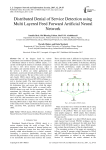
Distributed denial of service detection using multi layered feed forward artificial neural network
Статья научная
One of the dangers faced by various organizations and institutions operating in the cyberspace is Distributed Denial of Service (DDoS) attacks; it is carried out through the internet. It resultant consequences are that it slow down internet services, makes it unavailable, and sometime destroy the systems. Most of the services it affects are online applications and procedures, system and network performance, emails and other system resources. The aim of this work is to detect and classify DDoS attack traffics and normal traffics using multi layered feed forward (FFANN) technique as a tool to develop model. The input parameters used for training the model are: service count, duration, protocol bit, destination byte, and source byte, while the output parameters are DDoS attack traffic or normal traffic. KDD99 dataset was used for the experiment. After the experiment the following results were gotten, 100% precision, 100% specificity rate, 100% classified rate, 99.97% sensitivity. The detection rate is 99.98%, error rate is 0.0179%, and inconclusive rate is 0%. The results above showed that the accuracy rate of the model in detecting DDoS attack is high when compared with that of the related works which recorded detection accuracy as 98%, sensitivity 96%, specificity 100% and precision 100%.
Бесплатно
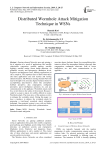
Distributed wormhole attack mitigation technique in WSNs
Статья научная
Sensing element Networks area unit gaining a lot of attention as a result of applications like sensible cities(traffic congestion, sensible parking, sensible lighting), sensible setting (forest hearth detection, air pollution) security and emergencies (Radiation levels, Explosive and dangerous Gases, Military applications) to call a couple of. The important facet of those observation and chase applications area unit security and sensing element location. The Wireless sensing element Networks may be thought to be associate degree freelance theme for accomplishing data-intensive chores like atmosphere (habitat) perceptive, data congregation, earthquake perceptive, parcel intelligence operation, etc. and any communication to the appliance. Wormhole attack could be a severe threat to the safety of the network. Because it could be a passive attack, it's terribly difficult to notice Wormhole attack. The most stress of this analysis work is to mitigate the wormhole attack. During this paper, we have a tendency to address the wormhole attack by proposing a trust-based wormhole attack mitigation technique. Our projected system is easy with no further hardware demand and no tight clock synchronization.
Бесплатно
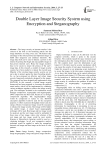
Double Layer Image Security System using Encryption and Steganography
Статья научная
The image security on internet transfers is the concern of the hour as the breaching attacks into the image databases are rising every year. The hackers take advantage of the stolen personal and important images to fulfill their dangerous and unethical intentions. The image data theft can be used to defame a person on the internet by posting the illegal and unacceptable images of that person (internet user). Hence the images transfers have to be secure to ensure the privacy of the user's image data. In this research, a number of image security systems have been studied to evaluate the research gap. Majority of the existing image security systems are not up to date to protect against the latest breaching attacks. So, we have proposed an effective and robust image security framework particularly designed for the images. The proposed has been designed and implemented using MATLAB. In this research, a hybrid image security framework has been proposed to overcome the problem stated earlier, which will be implemented by combining various techniques together to achieve the image security goal. The techniques included in the combination would beimage compression, cryptography andsteganography. DWT compression has been used, because it is a stronger compression algorithm. The steganographed image would be compressed to reduce its size. Blowfish encryption algorithm would be used for the encryption purposes. It offers maximum throughput (faster) and also energy efficient. Compressed image would be encrypted to enhance the image security. Real image will be hidden into another image. A cluster based steganographic technique will be used. Real image and face image would be analyzed, and the real image would be embedded in those areas of face image, where color schemes of the real image and face image would be most similar. Kmeans or Hierarchical clustering would be used as a clustering technique. An all new comparative analysis technique would be applied to make the comparison between real image and base image on the basis of color patterns.
Бесплатно
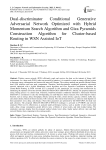
Статья научная
Wireless sensor network (WSN) efficiently sends and receives the data on the internet of things (IoT) environment. As a large-scale WSN's nodes are powered by batteries, it is essential to create an energy-efficient system to decrease energy consumption and increase the network's lifespan. The existing methods not present effectual cluster head (CH) selection and trust node computation. Therefore, dual-discriminator conditional generative adversarial network optimized with a hybrid Momentum search algorithm and Giza Pyramids Construction algorithm for Cluster Based Routing in WSN Assisted IoT is proposed in this manuscript, for securing data transmission by identifying the optimum CH in the network (DDcGAN-MSA-GPCA-CBR-WSN-IoT). Initially, the proposed method is acting routing process via cluster head. Therefore, Dual-Discriminator conditional Generative Adversarial Network (DDcGAN) is considered to select the CH depending on multi-objective fitness function. The multi-objective fitness function, such as energy, delay, throughput, distance among the nodes, cluster density, capacity, collision, traffic rate, and cluster density. Based on fitness function, CH is selected. After cluster head selection, a malicious node depends on three parameters: trust, delay, and distance. These three parameters are optimized by hyb MSA-GPCA for ideal trust path selection. The proposed DDcGAN-MSA-GPCA-WSN-IoT technique is activated in PYTHON and network simulator (NS2) tool. Its effectiveness is analyzed under performance metrics, such as number of alive nodes, dead nodes, delay, energy consumption, packet delivery ratio, a lifetime of sensor nodes, and total residual energy. The simulation outcomes display that the proposed method attains lower delay, higher packet delivery ratio and high network lifetime when comparing to the existing models.
Бесплатно

